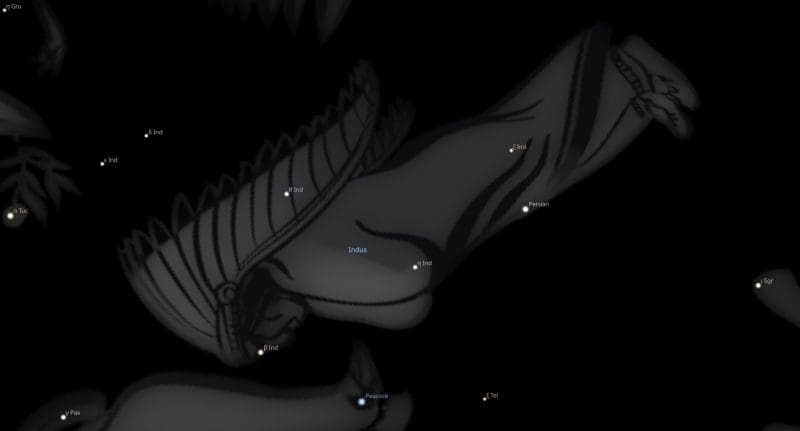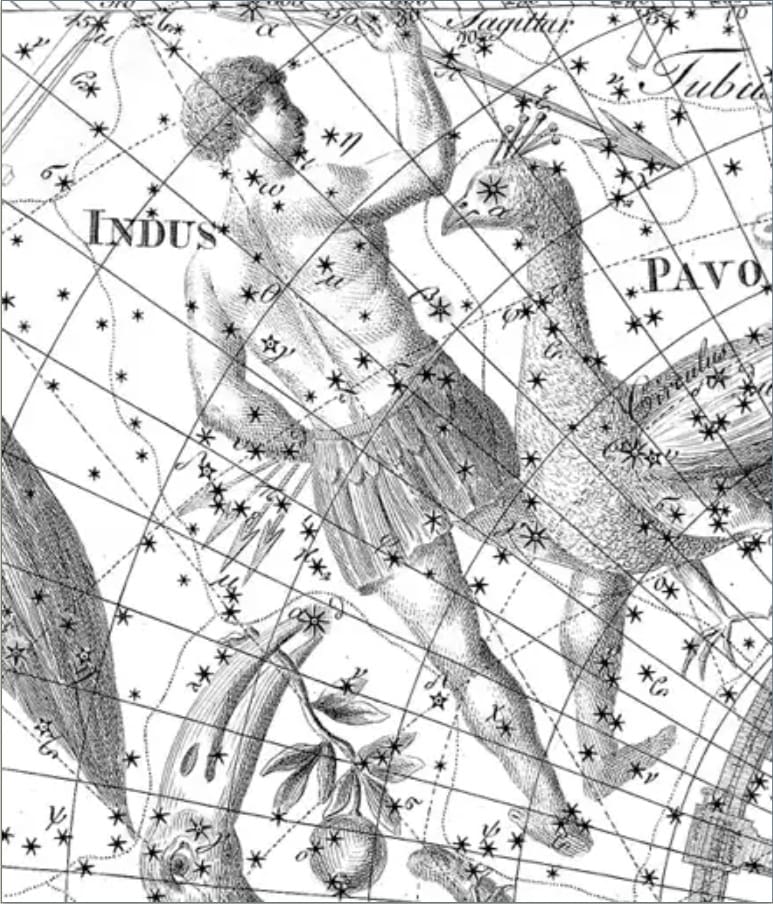FIXED STARS: Major Stars | 1000+ Stars | Constellations | About
Constellation Indus the Indian is a southern constellation bordering Grus, Tucana, Pavo and Microscopium.Indus was introduced by Johann Bayer in 1603 and remains one of the 88 modern constellations. It spans 30 degrees of the zodiac in the Signs of Capricorn and Aquarius.
Dutch navigators formed Indus on their voyages to the East Indies at the end of the 16th century. Early depictions suggest it represents a native of Madagascar. [1]
Abbreviation: Ind
Genitive: Indi
Indus Constellation Stars
| 2000 | 2050 | Star | Name | Sp. Class | Mag. | Orb |
|---|---|---|---|---|---|---|
| 27♑47 | 28♑29 | β Ind | K0 | 3.67 | 1°40′ | |
| 28♑40 | 29♑22 | η Ind | A6 | 4.51 | 1°10′ | |
| 29♑06 | 29♑48 | α Ind | Persian | K0 | 3.11 | 1°50′ |
| 04♒12 | 04♒54 | θ Ind | A5 | 4.39 | 1°10′ | |
| 09♒41 | 10♒23 | ε Ind | K5 | 4.69 | 1°00′ | |
| 09♒48 | 10♒30 | δ Ind | F0 | 4.40 | 1°10′ |
α Ind has the traditional Chinese name 波斯二 Bōsīèr, “2nd star of Persia.” [2] Allen called it Pe Sze from the title of the whole asterism 波斯 Bōsī, “Persia.” The title of the Persian for α Ind came from Jesuit missionaries in China. [3]
Indus Astrology
INDUS. The Indian.
History. Formed by Bayer, 1604.
Influence. It is said to give a quick penetrating mind, deep insight, and interest in orientalism, mysticism and sport. [4]
Allen
Indus, the Indian. It is one of Bayer’s new constellations, south of the Microscope, between Grus and Pavo, and, although generally supposed to represent a typical American Indian, its publisher drew it as a far more civilized character, yet nude, with arrows in both hands, but no bow.
Indus, or its lucida α, was Pe Sze in China, where it also was known as the Persian, a title from the Jesuit missionaries.
Gould assigned to it 84 naked-eye stars, from 3.1 to 7th magnitudes. [5]
References
- Indus The Indian, Star Tales, ianridpath.com
- List of Chinese Star Names – Wikipedia.
- Fixed Stars and Constellations in Astrology, Vivian E. Robson, 1923, p.48.
- Star Names: Their Lore and Meaning, Richard H. Allen, 1889, p.250.
- Alpha Indi – Wikipedia.

